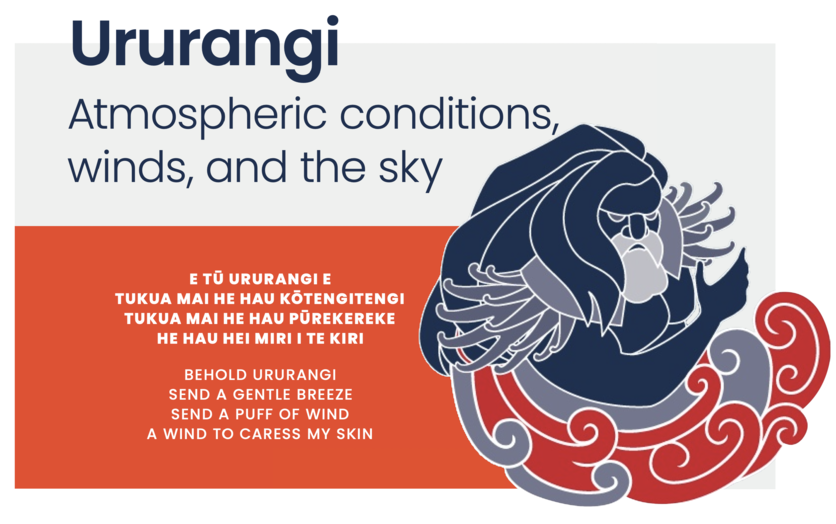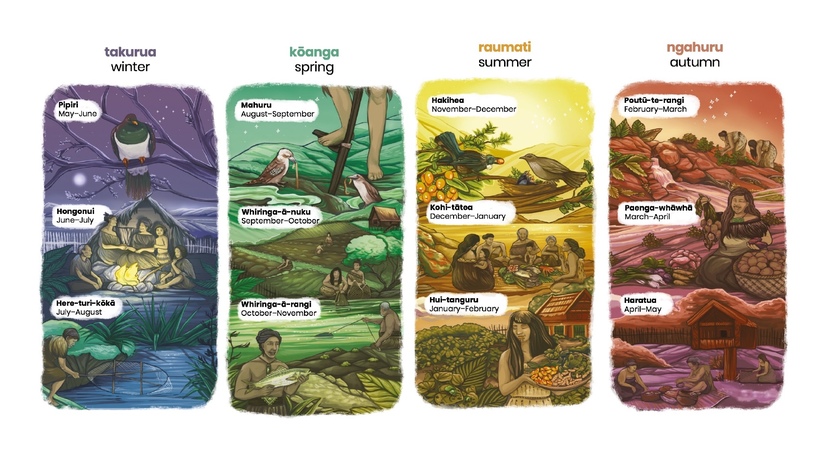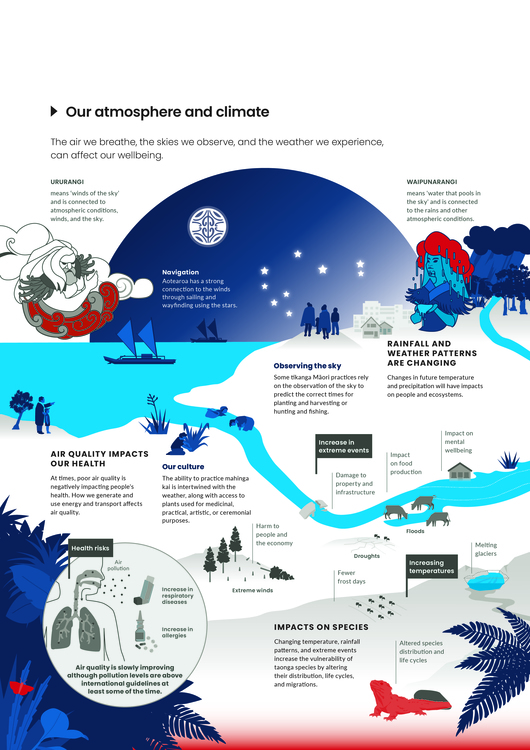Ururangi is a whetū in the Matariki cluster. It is connected to atmospheric conditions, winds and the sky. Ururangi means ‘winds of the sky’ and is associated with the various types of winds and the weather patterns each brings. Ururangi resides in the domain of Tāwhirimātea, the atua of the winds and weather.
Aotearoa New Zealand’s Ministry for the Environment and Stats NZ have produced Environment Aotearoa 2022 as part of its environmental reporting series. Environment Aotearoa 2022 has a unique approach that uses Te Kāhui o Matariki as the guiding framework for the report. Learn more about this approach in the article Environment Aotearoa 2022 – introduction.
Our interactions with Ururangi can be seen in the quality of the air we breathe, the visibility of the night sky and the winds that fill the sails of our past and present ocean navigators. The winds and atmosphere are matangaro – an invisible phenomenon. We can detect them by the interactions they have with the sea, people, landscapes, ecosystems and living beings. The winds and atmosphere have mauri, and our interactions with them affect our own mauri.
There are 500 distinct types of winds with different personalities and names. For example, te hau māngere is the lazy wind. Te haututū is the mischief wind which can also be referred to our children who are called haututū, mischievous but curious personalities.
Rereata Makiha, quoted in Environment Aotearoa 2022
Observing the skies
Observations of the sky inform specific tikanga Māori and are essential for readings of Matariki, which provides predictions for the year ahead. The changing of the seasons is tracked through observing the appearance of certain stars and the changing path of the Sun. The maramataka provides a framework for understanding te taiao and informing cultural practices. Observing tohu adds to and tests knowledge of the environment and allows that knowledge to be shared. Being able to follow the maramataka and observe Matariki and other celestial tohu is reliant on being able to see the sky to optimise times for harvesting, planting and growing food.
Ururangi and observation of the winds and skies also link to the first peoples who arrived in Aotearoa. Navigation of the waka hourua, used to travel across the vast Pacific Ocean, utilises wayfinding and other means to locate land. The links to first peoples, such as Kupe, Māui, and Rata – and their navigating achievements – connect many Māori to their ancestral practices and tūpuna.
Observing the night sky is a global experience – humans have long used constellations to tell stories or to represent who we are. Aotearoa has a growing number of international dark sky areas, which interweave the natural, cultural, scientific and astronomical heritage values of the sites. There is also a growing revitalisation of tātai arorangi.
Ururangi and wellbeing
Our interactions with Ururangi influence our wellbeing. Utilising the wind for recreation, like sailing, is part of who we are as a nation. We are increasingly harnessing the wind to enhance our electricity generation. Air quality is slowly improving at most measurement sites across the motu, but there are still concerns. Air pollution can still affect human health, even at very low concentrations.
Light pollution also has negative impacts. For some Māori, not being able to clearly see the night sky has implications for cultural connections and tikanga, as described above. Light pollution is concentrated in urban areas, and it is estimated that 56% of New Zealanders live in areas where the Milky Way is not visible due to artificial brightness. Artificial lights also pose problems for the nocturnal creatures of Aotearoa – such as our native moths.
Extreme winds can cause significant harm to people and infrastructure. Damage caused by extreme weather events like tornadoes and extra-tropical cyclones impact our physical and mental wellbeing and have significant economic consequences.
Actions to support Ururangi
There are small things that we can do to support Ururangi. A major source of air pollutants (and greenhouse gases) is vehicle emissions. When COVID-19 restrictions caused a pause in driving for 2 months in 2020, there were large reductions in air pollutants and emissions. Walking, biking and using public transport help to make a difference.
Investigate light pollution and raise public awareness with international citizen science projects like Globe at Night or Loss of the Night.
Step outside and simply observe. The domain of Ururangi may seem matangaro at times. Take time to notice whether the wind against your cheek is lazy or mischievous. Look up at the night sky and observe the whetū that continue to connect us with the past and the future.
Related content
The Hub has extensive articles, activities and media that support learning about the air, winds and sky. Explore these curations:
Our air 2024 reports on pressures that our activities put on air quality and how these changes to the state of the environment can impact our lives.
The Science Learning Hub team has curated a collection of resources to support Matariki and Environment Aotearoa 2022. This collection provides additional context and pedagogical insights. Sign in to make this collection part of your private collection, just click on the copy icon. You can then add additional content and notes, make other changes and share and collaborate with others.
Useful links
Stats NZ and the Ministry for the Environment report on different aspects of Aotearoa New Zealand’s environment every 6 months. Access their reports here.
Read the Stats NZ and the Ministry for the Environment reports Our air 2021 and Our atmosphere and climate 2020.
Visit Stats NZ for more information on:
The Royal Astronomical Society of New Zealand has a Dark Skies Group that advocates for minimising light pollution, arguing: “Outdoor lighting in New Zealand, as part of Urban Design, is in urgent need of review to ensure minimal wastage of energy and to minimise impacts on human health and natural and cultural systems.” Explore this view, as well as their information on light pollution and monitoring our night skies, which contains useful information about other methods for investigating light pollution.
With less light pollution, there are many great areas for stargazing in New Zealand. The areas below are of particular note:
- Aoraki-Mackenzie International Dark Sky Reserve – the largest gold standard International Dark Sky Reserve in the world. This gained its dark sky designation in 2012.
- Aotea/Great Barrier International Dark Sky Sanctuary – in 2017, this became the first island in the world to receive International Dark Sky Sanctuary status.
- Stewart Island/Rakiura International Dark Sky Sanctuary – the second island in the world to receive International Dark Sky Sanctuary.
- Wai-iti Recreational Reserve and Tunnicliff Forest, Nelson – in 2020, this became the first International Dark Sky Park in New Zealand.
- Wairarapa Dark Sky Reserve – in 2023 this became one of just 23 International Dark Sky Reserves in the world, Aoraki-Mackenzie is the other one in New Zealand.
- Kaikōura International Dark Sky Sanctuary – in 2024 this became the twenty-second location globally to earn this recognition and the third New Zealand sanctuary.
- Oxford Forest Conservation Area – in early 2024 this became the sixth International Dark Sky Park in Aotearoa.
- Tāhuna Glenorchy Dark Sky Sanctuary – in early 2025 this became the fifth designated Dark Sky Sanctuary in Aotearoa
Find out more at The International Dark-Sky Association – the recognised authority on light pollution and one of the leading organisations combating light pollution worldwide, with a range of informative posters, brochures and infographics. Explore the locations of the various International Dark Sky places around the world on the Find a Dak Sky Place section.
This 2020 New Zealand Geographic article Let there be night explores how artificial lights affect us and the environment around us.
Acknowledgement
This resource has been produced in collaboration with the Ministry for the Environment and Stats NZ.




